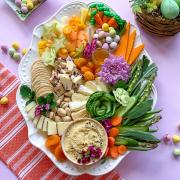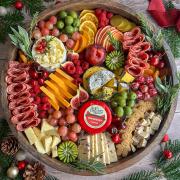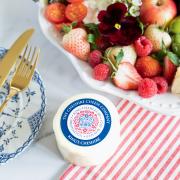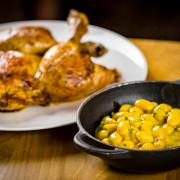James Wood from Bollington is a renowned wild food forager. He treats us to his Cheshire Elderflower Cheesecake recipe, so head for the hills

I live in Bollington and this is a great area for foraging. Most of my foraging is near the White Nancy monument although I do like to venture over to Delamere for mushroom season as well a couple of other secret locations around Cheshire. I’ve lived here all my life and I’ve developed a wild food map which is currently stored in my head. I’ve always been interested in foraging in some form, from collecting sticks, flowers and leaves when I was a child - the sticks had names, gangs and two of them even got married at one point! - to where I’m at now learning the in-depth uses of everything that grows wild around us. I developed a more professional approach after finishing a fine art degree where my area of specialism grew into extracting organic colours from wild plants. However, I take a personal interest in the potential for plants for food as flavours and tastes are the easiest way to get people excited about the outdoors, I’ve found. Every year I wait expectantly for the fragrant bloomage of elder flowers as they burst into season, signalling the summer’s beginning. I can begin those sun-filled days on the Cheshire plains, foraging, feasting and exploring what the wild spaces surrounding me have to offer, from hunting for mushrooms through Delamere Forest to sitting collecting bilberries from Cheshire’s peak district site at Tegg’s Nose Country Park. Elder can be found growing almost everywhere you look in Cheshire, however a specifically good spot is down the Middle Wood way in Bollington – where I’ve collected the elderflowers for this recipe. This is truly seasonal and local produce; let’s celebrate the Cheshire countryside on our plates.
Elderflower Cheesecake
This cheesecake recipe will give you a beautifully light, creamy and irresistible dessert to wow your family with at the end of a Sunday roast or surprise guests with at a Saturday night dinner party. The cheesecake topping melts in your mouth giving you the delicate flavours of elderflower while the crunchy base gives an exciting contrast.
What you’ll need Base: 170g Digestive Biscuits 50g Unsalted butter

Topping: 500g Full fat soft cheese 300ml whipping cream 3 tablespoons elderflower cordial 2 tablespoons icing sugar
Method Melt the butter, crush the digestives and thoroughly mix the two together. Place this mixture in the base of your cake tin and use the back of a spoon to push it down, ensuring it’s firm and even. Place this in the fridge whilst we make the topping. In a bowl mix the soft cheese with the elderflower cordial and icing sugar until smooth and even. In a separate bowl whip the cream until it’s light and fluffy. Fold the soft cheese mixture in to the cream and spoon over the set crumble base. Chill in the fridge for three hours. Enjoy with cream.

Elderflower Cordial
This cordial brings a vibrant, zesty and fragrant spark to everything it’s added to. I drink elderflower cordial with everything from chilled soda water to G&T and even prosecco. It’s brilliant on a lazy day reading a book in the garden or hosting guests at home in Bollington.
What you’ll need:
2kg caster sugar
Juice and zest of 5 lemons
15 flower heads
1.5 litres water
Method
Place the water and sugar in a large pan and heat until the sugar is fully dissolved.
Add the rest of the ingredients and simmer for 15 minutes.
Strain off the liquid through a muslin cloth or fine sieve, let it cool and bottle in to sterilised or cleaned bottles.
Store in the fridge and use within two months.
Elder – “Sambucas Nigra”
Habitat: Enjoys moist and dry soils, is almost always found in a sunny spot, this tree can be found in hedgerows, woodlands, garden edges, farmers’ fields, walkways, playing fields and commonly by the canals of Cheshire.
Physical Characteristics: Elder is a deciduous shrub or small tree, growing up to 6m tall and the same wide. The bark of this tree is a light brown-grey and can be found cracking with a yellowing revealed in between cracks.
The light green and lightly serrated leaves, spear shaped are 5-12cms long and 3-5cms wide, grow in opposing pairs, arranged with five to seven pairs.
The flowers 5-6mm in diameter each have five petals and are borne in large, flat umbrellas which are 10-25cms in diameter.
The fruit grows similarly to the flowers in large collections, they are almost perfectly round, glossy dark purple and measure 5-6mm in diameter, they cause the branches they hang on to droop when they are ripe.
Pick the flowers when they are in full bloom, for us we find that Elder flowers will be out in full force at the beginning of June, however with the cold weather we’ve had this year I expect them to be out from mid to late June.
About James Wood
James Wood, aged 25, from Bollington, is a renowned experimental wild food forager running wild food cookery and foraging courses throughout Cheshire. He lives in Bollington and has been demonstrating a passion for food foraging for many years. He wrote ‘The Foraged Book Project’and is in the process of turning it into an E-book which will be available through his website in the coming months. It’s a wild food, plant and material making guide made entirely from wild plants.
James is available for educational talks and tasting sessions for schools and colleges.
www.totallywilduk.co.uk @totallywilduk



























